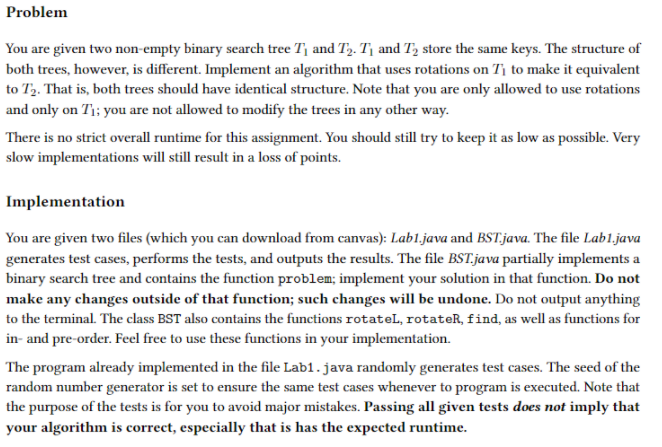Question
I need help with an iterative implementation to this problem. It is coded in Java and only needs the method problem implemented with no other

I need help with an iterative implementation to this problem. It is coded in Java and only needs the method problem implemented with no other helper methods.
Other times this question has been posted it had only been done recursively.
Here are the two other files with supporting code for this assignment Lab1.java and BST.java:
import java.io.*; import java.util.*;
public class Lab1 {
// --------------------------------------------------------------------- // Do not change any of the code below!
private static final int LabNo = 1; private static final Random rng = new Random(190718);
private static boolean testProblem(int[][] testCase) { int[] arr1 = testCase[0]; int[] arr2 = testCase[1];
// --- Build tree ---
BST tree1 = new BST(); BST tree2 = new BST();
for (int i = 0; i
int[] pre2 = tree2.getPreOrder();
BST.problem(tree1, tree2);
// --- Verify tree. ---
int[] pre1 = tree1.getPreOrder(); int[] in1 = tree1.getInOrder();
if (in1.length != arr1.length) return false;
for (int i = 0; i
return true; }
public static void main(String args[]) { System.out.println("CS 302 -- Lab " + LabNo); testProblems(1); }
private static void testProblems(int prob) { int noOfLines = 100000;
System.out.println("-- -- -- -- --"); System.out.println(noOfLines + " test cases for problem " + prob + ".");
boolean passedAll = true; long start = System.currentTimeMillis(); for (int i = 1; i
try { int[][] testCase = createProblem(i); passed = testProblem(testCase); } catch (Exception ex) { passed = false; exce = true; }
if (!passed) { System.out.println("Test " + i + " failed!" + (exce ? " (Exception)" : "")); passedAll = false; break; } } System.out.println((System.currentTimeMillis() - start) + " ms"); if (passedAll) { System.out.println("All test passed."); }
}
private static void shuffle(int[] arr) { for (int i = 0; i
private static int[][] createProblem(int testNo) { int size = rng.nextInt(Math.min(200, testNo)) + 1;
int[] numbers1 = new int[size]; int[] numbers2 = new int[size];
for (int i = 0; i
shuffle(numbers1); shuffle(numbers2);
return new int[][] { numbers1, numbers2 }; } }
import java.io.*; import java.util.*;
public class BST { /** * Problem: Perform rotations on tree1 to make it equivalent to tree2. */ public static void problem(BST tree1, BST tree2) { // Non-recursive implementation here }
// --------------------------------------------------------------------- // Do not change any of the code below!
private class Node { public Node left = null; public Node right = null; public Node parent = null; public int key; public Node(int key) { this.key = key; } }
private Node root = null;
public int getRootKey() { return root.key; }
private Node find(int key) { for (Node cur = root; cur != null;) { if (key cur.key { cur = cur.right; } } return null; }
// x y // / \ / \ // a y => x c // / \ / \ // b c a b private void rotateL(Node xNode) { Node xPar = xNode.parent; boolean isRoot = xPar == null; boolean isLChild = !isRoot && xPar.left == xNode; Node yNode = xNode.right; Node beta = yNode.left; if (isRoot) root = yNode; else if (isLChild) xPar.left = yNode; else xPar.right = yNode; yNode.parent = xPar; yNode.left = xNode; xNode.parent = yNode; xNode.right = beta; if (beta != null) beta.parent = xNode; }
// y x // / \ / \ // x c => a y // / \ / \ // a b b c private void rotateR(Node yNode) { Node yPar = yNode.parent; boolean isRoot = yPar == null; boolean isLChild = !isRoot && yPar.left == yNode; Node xNode = yNode.left; Node beta = xNode.right; if (isRoot) root = xNode; else if (isLChild) yPar.left = xNode; else yPar.right = xNode; xNode.parent = yPar; xNode.right = yNode; yNode.parent = xNode; yNode.left = beta; if (beta != null) beta.parent = yNode; }
public void insert(int key) { if (root == null) { root = new Node(key); return; } Node par = null; for (Node node = root; node != null;) { par = node; if (key node.key) { node = node.right; } else // key == node.key { // Nothing to do, because no value to update. return; } } // Create node and set pointers. Node newNode = new Node(key); newNode.parent = par; if (key
public int[] getInOrder() { if (root == null) return new int[] { }; Stack public int[] getPreOrder() { if (root == null) return new int[] { }; Stack
Step by Step Solution
There are 3 Steps involved in it
Step: 1

Get Instant Access to Expert-Tailored Solutions
See step-by-step solutions with expert insights and AI powered tools for academic success
Step: 2

Step: 3

Ace Your Homework with AI
Get the answers you need in no time with our AI-driven, step-by-step assistance
Get Started


